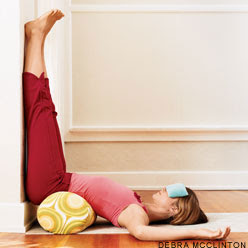By Timothy McCall, M.D
One reason yoga is a powerful means to build mental health is because its aim is higher than traditional psychology's. Psychology, like its counterpart modern medicine in the physical plane, tends to view mental health as the absence of negative states such as depression or anxiety. In contrast, yoga, as a holistic science, views health as representing a high level of physical, psychological, and spiritual well-being. (Luckily, there is a movement afoot, led by such pioneers as psychologist Dr. Martin Seligman, to bring more focus on what they are calling "positive psychology.")
Rather than simply help you feel less sad or anxious—which yoga can also do (see Yoga for Depression,
Parts I and
II and
Yoga for Anxiety and Panic Attacks, the practice can put you in touch with sukha, a deeper sense of calm or ease. Yoga teaches that joy, or ananda, lies deep inside each of us, and its various tools are simply a means to get at what's already there, so you can experience it fully. Yoga also addresses such issues as meaning, life purpose, and your connection to others and the world around you, which can have profound effects on happiness and health.
But beyond personal well-being, yoga seems to facilitate the development of qualities such as compassion, forgiveness, equanimity, and a desire to help others. Spiritually evolved beings seem to have boundless compassion for the suffering of others and a remarkable ability to forgive those who trespass against them (think of the Dalai Lama or Nelson Mandela). Just looking into the eyes of some yogis, you can sense their inner gratitude and joy. The question is, how do you get there (or closer to there)? And for yoga teachers and therapists, how can you help your students reach this state?
While the asanas are a great place to start—and almost everyone would benefit from including at least some asanas in their practice—I believe that combining the physical postures with other yogic tools is an even more effective way to grow spiritually. Tools as diverse aspranayama, meditation, philosophical understanding, and selfless service (or karma yoga) help you grow in joy, compassion, and equanimity, working synergistically to deepen the effects.
The BreathThe mind, according to yogic teachings, is the cause of most suffering. Yogis began systematically studying the mind, and the tricks it plays, thousands of years before the field of psychology was even invented. Probably the most important tool the ancients uncovered for taming the runaway mind was the breath. Simply slowing your breathing and making it smoother and more regular can relax the nervous system and, when the nervous system is relaxed, the mind often follows. In sutra I.34, Patanjali suggests that by focusing on the exhalation in particular, such spiritual qualities as cheerfulness, equanimity, and compassion can be developed.
People who are stressed, as well as those who are unhappy, angry, or worried about "getting theirs," tend to live in a state of physiological arousal. Their sympathetic nervous systems ("fight or flight") may be activated most of the time. Slow, regular breathing tends to shift the balance to the more relaxing and restorative parasympathetic nervous system (PNS), which all by itself can help people tap into the joy that lies at your core. Prolonging the exhalation relative to the inhalation can be an even more powerful way to increase PNS dominance.
Suggest students with less experience gradually lengthen their exhalations, slowly working toward a 1:2 ratio, with the exhalation twice as long as the inhalation. For those who are ready for it, add a brief retention after the exhalation to deepen the effects. Be cautious, though: If you push pranayama farther or more quickly than you should, it can agitate the nervous system, potentially exacerbating precisely what you are trying to help.
Warn your students that although pranayama techniques may not look like much, they can do serious damage to the nervous system and to the psyche when they are improperly applied.
Particularly dangerous are fancy ratio breathing and prolonged breath retention—the very tools that may be most intriguing to enthusiastic new students. Any straining, air hunger, or gasping during the practice signals they are pushing things too far. Likewise, restlessness, agitation, or difficulty sleeping in the hours or days after practicing are warning signs of overaggressiveness.
When practiced with patience and care, however, yogic breathing can be a doorway to peace of mind and personal transformation.






















